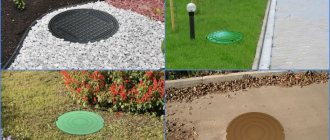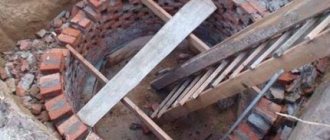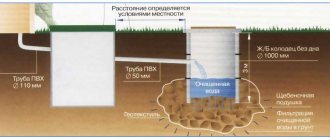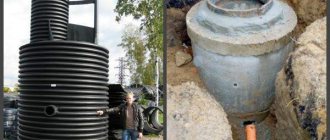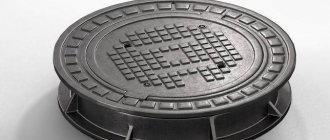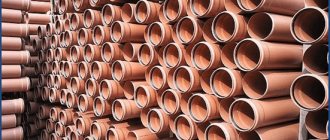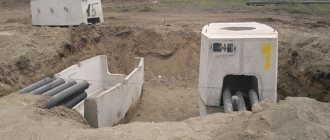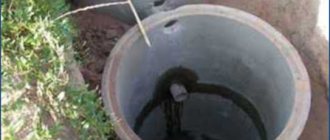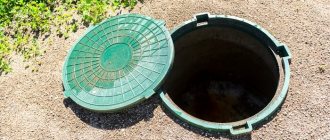A plastic sewer hatch is necessary to protect the sewage system from waste and debris, as well as to prevent possible damage and theft. One of the most common materials for the manufacture of such hatches is polymer.
The described products represent one of the important parts of the drainage structure. They are capable of withstanding an impressive load, sometimes up to 20 tons. With the help of such hatches it is possible to reduce the slipping of cars on the roads. Such products are installed in the garden plots of cottages, private houses and dachas, as well as on pedestrian sidewalks and in garden and park areas.
In the production process, a polymer-sand mixture is used. But special additives help improve the characteristics of the product. This includes water resistance, as well as long service life and frost resistance. And the appearance deserves attention. If cast iron products are unsightly and are presented in a traditional color, then polymer ones look more attractive and can have different shades, which allows the hatch to fit into the exterior.
General information
Lids are made from
- Cast iron. Such hatches are installed in areas with heavy loads. The material is very strong, heavy, durable.
- Polymers. Used for installation in private homes and park areas.
- Concrete. Products made from this material are heavy and have poor sealing properties, but they are great for non-standard necks.
Manufacturers offer hatches of different shapes
- Round
- Square
- Triangular
- Oval
- And all kinds of covers of non-standard geometric shapes.
Triangular, oval and “exclusive” are extremely rare. Square and rectangular ones can be seen more often. The vast majority use round hatches. They are the easiest to install. Round cast iron sewer manholes have a diameter from 380mm to 810mm.
Polymer round caps are available with a diameter of 315-1000mm. Square products are offered with rib lengths from 300mm to 800mm, dimensional increments of 50mm.
Plastic hatches
Polymer hatches are marked in the center of the cover - a letter.
- V-plumbing
- G-hydrant
- K-sewer
- D-rain inlet
- TM-highway automobile
- TS-heat network
- GS-gas network
- GKS-city cable network
- GTS - city telephone network
Knowing the designations makes it easier to choose the right cover for the well.
Attention. When choosing a round hatch, two indicators should be taken into account: internal and external diameters. The diameter of the neck must be the same as the inner diameter of the hatch. The correct diameter ensures a sealed installation.
Sewer cover sizes
| Model | Class | Weight, kg) | Load (kg) | Application area | Serve (years) | dimensions |
| garden | A15 | 11 | 1500 | Park, garden, private house, cottage. | 50 | 540*540*80 |
| Green lungs | A15 | 10 | 1500 | Park, square, country house. | 20 | 750*750*80 |
| With locking device | A15 | 46 | 1500 | Pedestrian areas, parks. | 20 | 780*789*110 |
| Small-sized | A15 | 25 | 1500 | Park, light, pedestrian area. | 20 | 730*730*60 |
| Plastic lungs | A15 | 44 | 3000 | Inspection wells, parks. | 20 | 750*630*115 |
| Road averages | B125 | 50 | 12500 | Highways, sidewalks, parking lots | 50 | 780*780*110 |
Plastic products
- Light weight
- Do not rust
- Don't rot
- Resistant to aggressive environments
- Easy to install
Cast iron hatches
Cast iron covers are cast from SCh45, and the body is cast from SCh15. Sometimes a rubber gasket is installed between the hatch and the neck. The gaskets are made of high-strength rubber, which retains its properties for a long time.
The service life of cast iron covers is up to 100 years or more. Cast iron is not subject to deformation due to temperature changes, for this reason the destruction of the neck is minimized. The main disadvantages of cast iron hatches are that they are difficult to install and the covers are often stolen, and they are not cheap.
All products are manufactured on the basis of GOST. You can install the polymer hatch yourself. But you will have to install a cast iron or concrete cover with an assistant or use special equipment.
This is interesting: Types of septic tanks for home and garden - classification of treatment plants
Overview of manhole design
The design of the hatch is simple, functional and has not changed for decades. Recent innovations concern the development and installation of different types of locks.
Main details
The hatch has only 2 parts: a mounting rim is installed on the neck, and a cover is installed on top. It has protrusions that coincide with the grooves on the body.
Lids are made mainly:
- round: even incorrectly installed ones will not fall into the inspection shaft;
- with a ribbed surface: improved traction with pedestrian shoes and car wheels;
- flat or convex to prevent water from collecting.
To make opening easier, many modern lids are equipped with a hole through which they can be pryed with a hook. Holes are made only in the covers for sewer, water supply, drainage, and storm wells - water gets inside through them.
With or without lock
Locks are needed on cast iron hatches for several reasons:
- To protect against third-party penetration into wells that provide access to valuable equipment.
- If there is a lock on the cover, it cannot be installed incorrectly. Distortions with a loose fit can cause an accident on the road.
- Protects against theft for the purpose of selling for scrap metal.
Cast iron sewer hatch with a lock.
Locking devices come in several options:
- Flag connection installed between the cover and the rim. Lock with a secret.
- Threaded. The cover is screwed into the body and can get stuck, so this option is unreliable.
- A security bolt connecting both parts.
- A spacer mechanism on the lid that locks the product when closing.
- A crab with 2-6 beams on the hatch to block the entrance.
Access to the manhole with communications and electricity is blocked by 2 covers: protective and locking. The latter is located in the shaft of the shaft, made of steel, equipped with a lock to prevent unauthorized persons from gaining access to the cables.
Heavy products are equipped with simple locks in the form of protrusions that fit into the grooves of the neck. They open with special hooks. Flag, bolt or spacer locks are expensive and are installed on wells of communication and power supply networks that require increased protection.
Sewer hatch with a locking device.
What is it and what is it used for?
A sewer hatch is equipment designed to protect mines and wells, utilities, drainage and sewer systems from contamination, damage and to prevent theft of communication cables. Plastic products are used for accessibility of maintenance of communication networks and for the safety of pedestrians in places where wells are located.
Plastic sewer manholes are made using the pressing method from recycled high-density polyethylene and low-density polyethylene using modifying additives, as a result of which they have a long-lasting beautiful color and are resistant to precipitation and temperature changes. Made from durable, environmentally friendly material that is safe for humans.
They consist of a cover that opens 180 degrees and is fixed with bolts and a housing. The lids are flat and convex. To prevent unauthorized persons from opening and entering the wells, a locking device is provided. This is the cheapest and most suitable option for using them on the territory of summer cottages, individual houses, cottage towns, in garden and park areas, and sidewalks. They are also used in the construction of external communication networks, stadiums, and parks.
Kinds
The lid is made of different materials:
- Cast iron.
- Polymer (combined).
- Plastic.
- Concrete.
Cast iron
This is a classic solution when arranging a sewer system. The cast iron lid has a large mass. Because of this, difficulties arise during installation, as well as during their maintenance.
However, their excellent performance characteristics completely cover their disadvantages. On average, it will last up to 100 years with a maximum load of up to 100 tons. It is characterized by its low price and is used in the construction of highways and areas where the movement of lifting equipment is expected.
Polymer
Well sewer manhole, also known as polymer sand manhole.
In its production, a composite material from polymer and sand raw materials is used.
Mainly used in the construction of underground communications:
- Heating network.
- Telephone networks.
- Gas pipelines.
- Cable networks.
Due to its light weight, the polymer-sand cover is convenient to transport, install and lift when servicing certain communications. The material used copes well with thermal, acid-chemical and atmospheric loads.
Plastic
They have minimal weight. Due to this, it is easy to work with during installation. Mainly used for gardening or landscaping local areas.
May be green or some other color. Due to this, it will not be conspicuous, but will be successfully camouflaged. The PVC cover has a low cost compared to analogues. At the same time, the plastic hatch can cope with a load of up to 1.5 tons. Also allowed for installation in stadiums, squares and parks.
Concrete
You will not find such a sewer hatch on sale. They are made to order.
To do this, a hole is first prepared, its dimensions are measured, and then the filling process is carried out. You can do it yourself, the main thing is to prepare a form. There are varieties of concrete slabs/covers that immediately have a round hole. They are generally effective when installing large sewer pipelines that serve entire areas.
Pros and cons of each type:
| View | pros | Minuses |
| Cast iron |
|
|
| Polymeric |
|
|
| Plastic |
|
|
| Concrete |
|
|
Installation
Installation of different types of polymer products also has its own characteristics. Thus, a lightweight polymer-sand hatch is mounted to a depth of 25-45 mm, and a medium-heavy structure - to a depth of 60 mm. Heavy hatches are deepened the most - they are mounted 85 mm below ground level.
The installation process of a polymer structure begins with the installation of a ring (on a concrete floor). It is poured with cement mortar and left until completely dry. Next, the master installs the hatch cover itself.
A blind area is built around the well (with a slight slope). It is needed to prevent moisture from penetrating into the collector. usually varies from 1 to 1.5 meters. You can significantly simplify the process of installing a hatch by purchasing a product with special grooves for fastenings.
«High-quality products for any task"
Our company offers you polymer-sand hatches of our own production with various operational and technical characteristics. The assortment for sale creates the prospect of a thoughtful choice of a polymer hatch for a well in accordance with further conditions of use.
Today you can buy polymer hatches for wells of the following modifications:
Polymer hatch - Type L
| Characteristics | |
| Clip diameter | 750 mm. |
| Cover thickness | 40 mm. |
| Cap diameter | 630 mm. |
| Clip height | 115 mm. |
| Product weight | 30 kg. |
| 3 t. | |
| Cost (retail) | 800 rub./pcs. |
| Polymer hatch price (wholesale) | 600 rub./pcs. |
Lightweight polymer sand hatch (L). This model is intended for use as a cover for various types of wells located outside transport highways and road sections with increased load. The main area of use for polymer hatches of this type is landscape perimeters and local areas.
Polymer hatch - Type C
| Characteristics - polymer sand hatch | |
| Clip diameter | 750 mm. |
| Cover thickness | 40 mm. |
| Cap diameter | 630 mm. |
| Clip height | 115 mm. |
| Product weight | 40 kg. |
| 6 t. | |
| Cost (retail) | 900 rub./pcs. |
| polymer hatch price - wholesale | 650 RUR/pcs. |
Medium type polymer hatch (C).
This popular category of well hatches can withstand weight loads of up to 6 tons. Accordingly, such products can be used on roads with medium traffic loads and in any pedestrian areas.
Polymer hatch - Type T
| Characteristics - polymer hatch | |
| Clip diameter | 750 mm. |
| Cover thickness | 40 mm. |
| Cap diameter | 630 mm. |
| Clip height | 115 mm. |
| Product weight | 46 kg. |
| 15 t. | |
| Cost (retail) | 1000 rub./pcs. |
| polymer hatch price - wholesale | 700 rub./pcs. |
Heavy polymer well hatch (T). This type (load up to 12 tons) is intended for use without any significant restrictions, including installation on city roads, gas stations and other facilities with average traffic, with the exception of expressways and highways.
Application area
Polymer hatches are widely used in industrial, municipal and individual construction, in households, the main areas of application are:
Underground communications . Along the route of heating mains, gas, sewerage, water supply, electrical and telecommunications mains, technical wells are always installed for inspection and maintenance work, placement of control and measuring equipment, and storage of components. In all of the above cases, for protection and easy access, the wells are closed with polymer hatches, often with special locks to prevent unauthorized entry.
Private buildings . In households, to organize individual water supply, wells or boreholes are used, often located in underground caisson chambers. Many factory-made caissons have ready-made manholes made of plastic, providing protection and access to the internal space; sometimes they install similar underground chambers with their own hands, installing polymer sewer hatches on top. In individual households, home-made cellars located on the site, septic tank pits, and constructed wells at the points of connection (inset) to the centralized water supply, sewerage and gas mains are equipped with similar hatches.
Rice. 2 Plastic hatches with protection
With lock
Considering the theft of hatches, it is necessary to take care of their safety.
Therefore, it is quite logical to install a lock on it. Plus, it allows you to organize protection for the inspection well.
Advice! If its installation is carried out in a fenced local area, then a lock is not needed. If it is outside the fence, then it must be present.
To install the lock, you need to make a reliable frame. For sewer covers there are the following types:
- Spacer devices.
- Threaded connections.
- Flag.
This is interesting: Liquid for septic tanks and cesspools - review of products
DIY installation
Installation instructions for a polymer-composite, cast-iron and plastic hatch.
Tools
The following tool is required:
- Concrete mixer.
- Shovel.
- Master OK.
- Container for mixing the solution.
- Lifting equipment in case of installation of a heavy hatch.
Polymeric
- The first step is to install the hatch ring. To do this, you need a reliable foundation, for example, reinforced concrete or concrete. This overlap must be durable and of high quality.
- A correctly mounted support ring (OK) will allow the entire intended load to be evenly distributed. As a result, the possibility of destruction is completely eliminated.
- To fix the OK, a concrete solution is used.
- After installing the ring, you need to wait until the concrete is completely dry.
- After this, the OK covers are mounted. At the same time, it is not recommended to lay the polymer hatch itself directly on a concrete slab. It is also unacceptable to use lining elements, such as bricks and mortar.
- During the installation process, it is necessary to ensure that the laid hatch does not protrude from the ground, but is at the same level.
- For fixation, a blind area is constructed. It should have a slope in one direction to remove moisture and precipitation.
- To prevent the corrosion process, it is recommended to lubricate the upper working part with lithol.
Important! Do not use support rings made of low-quality material.
Cast iron
- First, install OK. It is important that it perfectly coincides with the opening of the sewer shaft.
- OK is filled with concrete on all sides.
- The installation of the casing must be carried out accurately so that it does not wobble from side to side, and the cover installed later is flush with the ground or asphalt.
- After pouring the concrete, immediately put the hatch in its place. While the concrete is drying, moving the lid or lifting it is unacceptable.
Plastic
- Mounted OK. It must have technological holes, thanks to which it is possible to perform fixation using anchors.
- OK (support ring) is filled with concrete.
- The ring fits the cover into the corresponding grooves.
- It is extremely important that it is level with the ground. Although in some cases the hatch may protrude slightly from the ground level.
- If there are certain irregularities, then formwork is installed at a distance of 400 mm on each side.
- OK is secured with anchors.
- The formwork is poured with concrete and is expected to dry completely.
The technology for installing a sewer hatch, regardless of its type, shape and material used, is almost the same. Difficulties may arise when working with concrete or cast iron products due to their heavy weight.
Installation stages
Also check out these articles
- A comfortable sofa is the key to a comfortable sleep and a cozy atmosphere
- Buffer tank in a heating system - what is it for?
- Features of a sewer septic tank for a summer residence
- Metal picket fence is the right solution for creating a high-quality fence
- A ring or shell is installed on the cover of the sewer shaft. This structural element reduces the load on the slab by almost three times. You can also use not a factory-made part, but ordinary brickwork. But, if the brick crumbles, the lid will fall into the shaft.
- In order to correctly install the ring, you should use a level and align the structure strictly horizontally. In order to avoid deformation or subsidence, the structure must not be installed at an angle.
- The entire outside perimeter of the ring should be concreted. The concrete mixture must harden completely.
- The unit is mounted in a ring. The entire working surface must be covered with grease or lithol. This technique will make it possible to open the hatch without problems even at sub-zero temperatures.
What types of hatches are there?
Typically, manholes are used to cover wells located in places where pipelines change direction, branch, or change in height—at these points the pipes are welded or soldered. Therefore, these areas have reduced tightness and strength - therefore, they need protection from the harmful effects of soil, moisture, as well as periodic inspection. Depending on the materials of manufacture, inspection hatches are divided into the following groups:
Cast iron. Traditional hatches are made of thick and durable metal with a service life of up to 80 years, the disadvantages of which are high cost and, accordingly, an increased risk of theft of a “penny”. Factory-made cast iron hatches are subject to GOST 3634-99, which divides products into several categories based on weight, outer diameter of the cover and shell (ring), installation depth and withstand loads. The standard hatch diameter of all products is 550 mm, the weight ranges from 45 to 150 kg, the rated load of the strongest hatch reaches 6000 kg (600 kN).
In addition to the standard design, cast iron hatches are produced in the following modifications (the numerical order corresponds to the number in their designation):
1 - general purpose;
2 — with a locking lock;
3 - with a recess in the lid for filling with cement or concrete composition;
4 - with a cover design for lifting with special lifts;
5 - with a body reinforced with anchors or ebbs;
6 - with a two-piece lid;
7 — with a lid on hinges;
8 - having a rectangular (square) hole.
Rice. 3 Marking and parameters of cast iron hatches according to GOST 3634-99
Plastic. As in all areas of manufacturing building materials and components, individual small production and commercial firms are always ahead of the slow-moving public sector, so plastic sewer manholes of various designs, shapes, and colors are presented on the construction market. Since the products on the market are relatively new, a special GOST has not been developed for them; each manufacturer supplies its products with individual hole diameters, thickness and weight of the product. Typical sewer manholes made only of plastic are expensive, have low strength and are practically not found on the market; only small inspection hatches for limited use or individual covers are made of plastic.
Rice. 4 Production of polymer-sand hatches - main stages
Polymer-sand (PSL). To make lightweight and durable hatches from synthetic materials, a technology is used that consists of mixing 3 main elements: polymers (30%), fine sand (69%) and iron oxide dye (1%). The manufacturing process consists of the following main stages:
- Purchased recyclables in the form of polymer waste from plastic bottles, films, are crushed and cleaned, after which they are mixed with sifted sand and a pigment of a certain color, the main colors are black, gray, brown, red and green.
- After placing the raw material into a melting and heating unit (MHA) with three heating zones from 50 to 450 °C, the output is a raw material structure ready for molding, in which each sand particle is coated with a polymer.
- The hot mass is weighed and loaded into the mold, then compressed with a press with a nominal force of about 150 tons for 2 minutes and then cooled, after which the product is ready for use.
To increase strength, the covers and rings are reinforced during the manufacturing process, after which polymer sand hatches can withstand loads of up to 30 tons.
Rice. 5 Dimensions of cast iron hatches type L and T according to GOST 3634-89
Types of polymer wells
First of all, all polymer wells differ in size, which directly affects daily sewage disposal. In addition, wells can be either with free access or without access at all. As for polymer wells with free access, they imply unhindered inspection or repair, and for those that are produced without access, maintenance is possible only from above.
Also, polymer wells differ from each other in texture and purpose. They may be the following:
- Smooth single-walled;
- Smooth double-walled;
- Corrugated single wall;
- Corrugated double-walled;
- Combined.
By purpose they are:
- Prefabricated inspection wells - designed for maintenance and technical inspection of storm or utility sewers.
- Sewer pipes – used to control and gain access to sewer pipes.
- Storm type - used to collect storm water.
- Sedimentary type - used to treat wastewater from precipitation.
- Drainage - used in the corresponding system as connecting and rotating elements.
- Differential - used to change the level of the pipeline. In turn, they come with a vertical, stepped and cutting-edge pipe.
- Caissons - designed for installation of pumps, shut-off equipment or electrical devices deep in the ground.
- Collector - used to connect sewer, storm drainage or drainage systems.
- Telecommunications - serve to monitor the connection points of cables and other equipment. Such wells are prefabricated and welded.
Depending on the functions performed, polymer wells are divided into the following types:
- Rotary;
- Observations;
- Stormwater;
- Mud;
- Cumulative.
Each of the listed types has its own characteristics.
When choosing a polymer well, you should pay close attention to its purpose immediately before purchasing
Rotary wells are used to clean pipes and are installed on the openings, inspection wells provide access to hydraulic communications, and storm wells are necessary to drain rainwater. Storage polymer wells completely replace cesspools and prevent the penetration of unpleasant odors into the area, while mud wells purify water from dirt and sediment.
In order to determine the number of polymer wells for a particular sewer system, it is necessary to strictly follow SNiP.
In addition, when purchasing a polymer well, you must also ensure that the following functional parts are available:
- Polymer hatches, which are mainly used for private households and places with rarely passing traffic;
- Covers – used to protect the well from the penetration of dirt and debris;
- Necks - used to narrow the top of the well, which can be central or offset;
- Stairs - used for quick access to the well;
- Anti-freeze funnels - used to prevent cold air from penetrating inside;
- Garbage collection containers - necessary for collecting waste on the internal surface.
In addition, polymer wells are:
- Made of polyethylene - they are used for such sewer systems as storm water, domestic and general sewer systems. Such wells are characterized by good tightness, resistance to corrosion, ease of installation and long service life.
- Made from polypropylene – they are very popular. The rings of these wells have different diameters, and the pipes can be double-layered or single-layered. As for double-layer pipes, they have an outer corrugated layer, which significantly increases the protection of the product from adverse conditions. In addition, corrugated pipes are characterized by a longer service life, environmental safety, durability and ease of installation.
- Polymer-sand - this type of material appeared on the construction market relatively recently, so it has not yet become popular. Such wells are made from a composite material that includes plastic and sand. Such wells are distinguished by their high tightness, which is achieved through a special connection of elements.
Functions and purpose
Its main task is to protect against the entry of debris, dirt, foreign objects, drains and other contaminants into the collector. Otherwise, the sewer system will quickly become clogged and will not perform its main function. Among other things, its presence allows for scheduled maintenance of the utility network or to eliminate the problem in the event of a blockage.
According to their purpose they are divided into:
- Lightweight , with a permissible load of up to 3 tons. Mainly for pedestrian areas.
- Heavy , with a permissible pressure of up to 20 tons. Used for highways.
- Super heavy , with a maximum pressure of up to 60 tons. Scope of application: airfields.
Classification by purpose
Marking in the form of a letter designation is applied to the sewer cover:
- water wells - “B”;
- sewerage - “K”;
- rain wells - “D”;
- heating network – “TS”;
- gas network - “GS”;
- main roads - “TM”;
- city cable network - "GKS";
- city telephone network - "GTS".
Designations of sewer hatches
Marking of hatches: water supply and sewer
To make it easier to select products, the lids are marked. On the outside there are letters with numbers.
The first letters indicate the permissible load on the hatch:
- L - lungs;
- C - average;
- T - heavy.
Further in brackets there is a marking according to GOST, which indicates the maximum load:
- A15 -1.5 t;
- B125 - 12.5 t;
- S250 - 2.5 t.
The letters after the brackets indicate the purpose of the hatches. Water pipes are marked with the letter “B”, sewer pipes – “K”, drainage pipes – “D”.
The following numbers indicate the design features:
- 1 - for general purposes;
- 2 - with locking lock;
- 7 — with a hinge;
- 8 - square shape.
The last numbers indicate the diameter or size of the sides in centimeters.
Example of marking: C (B125) K-2.60. Explanation: medium hatch, withstands 12.5 tons, sewer with a lock, diameter 60 cm.
An example of marking a sewer hatch.
Polymer hatches have appeared recently; there is no GOST for them. Manufacturers produce products with their own dimensions, thickness, and weight. Marking is practically not applied.
Introduction
Introduction
The standard specifies the types of hatches, the strength loads that hatches and installation locations must withstand, identical to the European standard: hatch L - class A15; hatch C - class B125, etc. This connection is reflected in the designation of hatches and rainwater inlets: hatch L (A15); storm water inlet DM1 (S250). The dimensions of the storm drain grate grooves and their location in relation to the curb stone are harmonized with the EN 124-1994 standard. Participating in the development were: M.Yu. Smirnov, S.V. Tsygankov (Kirov Plant OJSC, Kaluga region), V. A. Glukharev and V. P. Bovbel (Gosstroy of Russia), L. S. Vasilyeva (GP CNS), Yu. M. Sosner.
By load class
Depending on the maximum permissible load, products made of polymer material are divided into:
- light garden (L) – 1.5 t;
- light sewer (L ) – 3 t;
- medium sewer (C) – 7.5 tons;
- heavy sewer (T) – 15t;
- heavy main sewerage (TM) – 25 tons.
Classification of sewer manholes by load class
Material of manufacture
Today, cast iron hatches are most often found, since for a long time there was almost no alternative to the material. Concrete and steel products were occasionally used. Plastic lids have appeared recently, but they are expensive. Polymer ones are cheaper and superior in quality to plastic.
Cast iron
When the hatch is subjected to increased mechanical and weight loads, cast iron is the optimal solution. The service life of a product made from it is more than a century; it does not deform from frost or heat. Significant disadvantages of cast iron hatches are their large mass and high price.
At the enterprises, the lid and neck are cast, which can be with a cast iron rim and a concrete base. Some modern models are equipped with rubber gaskets. The metal of the body is less durable, the lid is stronger. The design can withstand heavy loads.
In home sewers, hatches are located where they are not subject to intense loads. Therefore, it is more rational to use models made of lighter and cheaper materials. Cast iron products are heavy, making them difficult to open.
Cast iron sewer hatch.
Polymer
In parks, garden paths, and cottages, polymer and plastic covers are more common. Plastic is an expensive material and is inferior in strength and durability to polymers. Large plastic covers are rarely found; small inspection hatches are mostly used.
Polymer sand products have become widespread. This is a synthetic material for the manufacture of which a special technology is used: 30% polymers, 69% fine sand and 1% iron oxide are mixed. The production uses recycled materials from plastic bottles, etc., so the products are cheap. After adding sand and heat treatment, the mass is pressed and cooled. Strength is increased by incorporating reinforcement into rings and caps.
Manufacturers pay great attention to the decorative design of lids. They are colored by adding pigments. Color camouflages the product or, conversely, attracts attention, signaling danger. The lids are often made in relief, with patterns and ornaments.
Polymer hatches are easy to use: they open and close easily and do not freeze to the neck in winter.
They have much less weight than cast iron lids, but they are much inferior in their ability to withstand loads. Therefore, polymer and plastic products are not installed on roads with heavy traffic.
Polymer hatch.
Structures made from other materials
Concrete hatches are most often used in the construction or renovation process . They are a reinforced concrete slab with protruding brackets with which it is moved.
If the product is of non-standard size or shape, it is covered with a reinforced concrete cover. In home sewers, these hatches are used to ensure the tightness of a well made of concrete rings or a rectangular monolith. Such products are made to individual orders.
Steel hatches are almost never used, because they are heavy, inconvenient, and rarely provide tightness. These products are used primarily as a second inner cover in shafts containing electrical and telephone cables. They are equipped with locks.
GOST and marking
Technical characteristics and requirements for sewer manholes are regulated by GOST 3634-99. This standard applies to covers of wells and chambers of underground networks of storm and city sewerage, water supply, heat supply, communications and gas pipelines.
The properties of telephone sewer manholes are regulated by GOST 8591-76.
Hatches made from modern polymer materials that do not meet GOST requirements are manufactured according to the customer’s technical specifications or according to the technical conditions developed by the manufacturer.
According to interstate standards, hatches are marked with alphanumeric abbreviations and are divided into the following types:
- ST (E600) - Extra heavy, designed for loads up to 61 tons. The hatch weighs more than 155 kg. Designed for installation in unloading terminals, airfields, and on expressways.
- TM (D 400) - Heavy highway. Designed for installation on high-speed roads. Easily tolerate local loads of up to 40 tons. They weigh up to 140 kg.
- T (250) - Heavy hatches are installed on urban roads with heavy vehicle traffic. The dead weight of heavy hatches can reach 120 kilograms. Designed for loads up to 25 tons.
- C (B125) Medium sewer structures, for installation in city yards, on sidewalks and lawns. Designed for loads of up to 12.5 tons. The weight of the structure is up to 95 kg.
- L (A15) Lightweight hatches that can withstand loads of up to 1.5 tons are installed in pedestrian areas where there is no traffic. They weigh 45-60 kg.
To simplify the procedure for selecting sewer manholes, manufacturers use special markings in accordance with the purpose of utilities:
- K - domestic and industrial sewerage;
- D - rain and storm drainage;
- GW - city water supply networks;
- B - water conduit;
- TS - heating networks;
- PG—fire hydrants;
- MG—trunk gas supply networks;
- GTS - city telephone networks.
According to State standards, sewer manholes must be equipped with special inscriptions and trademarks or logos of the manufacturer.
Fig.6. Storm drain hatch.
Short description
The manufacturing technology of polymer hatches is based on the method of casting and hot pressing of all material components (sand, thermoplastic polymers and dyes). This production method allows us to obtain a product that has the highest performance characteristics and has a presentable appearance.
Similar products are used by city water supply services, heating networks and road enterprises. In large-scale and private construction, sand-polymer manholes are also used for sewer installations. GOST 3634-99 and sanitary and environmental standards according to which the product is manufactured establish clear dimensions and basic qualities of the finished product. For this reason, the buyer does not have any difficulties with replacing lids, and the product itself is completely safe for the environment.
Main sizes
Sewer hatches usually have standard sizes corresponding to the dimensions of the wells.
The diameters of the hatches should allow service personnel to easily enter the well to carry out repair and maintenance work on the networks.
For sewer manholes, heavy, medium or light manholes are usually used.
Common dimensions of hatch bodies with covers:
- body 720 × 60 with cover 600 × 25;
- body 750 × 90 with lid 690 × 55;
- body 750 × 100 with lid 690 × 50;
- body 800 × 110 with cover 700 × 70.
Square hatches usually come in dimensions of 640 x 640 mm, with the cover size being 600 x 600 mm.
Fig.7. Heating main hatch.
Criterias of choice
When choosing hatches, you need to take into account the climatic conditions of the area, the purpose of the engineering systems running in the well, the location of the hatches, and possible maximum loads.
- For unguarded open areas, it is better to choose hatches equipped with locking devices. This will help avoid theft of products and protect the well from unauthorized entry.
- In parks, recreation areas and in the immediate vicinity of residential buildings, it is better to install composite and rubber structures that have good noise insulation properties.
- Covers intended for installation on the roadway must weigh at least 50 kilograms so that they do not move during heavy traffic.
On the territory of private households and summer cottages, you should not use expensive and bulky cast iron hatches. Polymer or composite hatches will withstand one-time loads from trucks or cars.
Manhole covers for sewer wells should not slam or make sharp sounds when impacted. The front surfaces must have a relief rough texture and have good grip on car tires and shoe soles.
Square cast iron hatch with holes DN600 with cover fastening, load D400
Square cast iron hatch without holes DN600 with cover fastening, load D400
Useful tips
Arranging a bathroom is quite a complex and painstaking job. Therefore, it is necessary to install plumbing hatches for the bathroom and toilet correctly, so as not to redo the door later, spoiling the lining of the room
We advise you to pay attention to the following nuances:
- When choosing a product, keep in mind that hatches come in horizontal and vertical orientation. Therefore, before purchasing it is necessary to take appropriate measurements.
- Be sure to use a level during installation.
- Considering that the sizes of hatches for bathrooms and toilets differ, small structures can be installed entirely, while large ones are usually disassembled into their component parts.
- When finishing with ceramic tiles, the cladding is done directly under the door, leaving the bottom row for last. This trick will help you avoid distortions and adjust all decorative elements to size.
These simple tips will help make the hatch in the bathroom or toilet less noticeable without spoiling the overall interior of the bathroom.
Popular brand
Sewer hatches from the German company ACO are ideal for Russian conditions.
They are distinguished by reliability, practicality and solid appearance.
ACO covers are made of anti-corrosion cast iron alloys with high wear resistance and resistance to aggressive reagents, petroleum products, and wastewater. The unique material allows you to create products with a high tensile strength. Neck frames can be made of plastic concrete or cast iron.
Fig.8. ACO manhole.
The advantages of ASO products are the presence of anti-vandal fastenings with which the covers are attached to the necks of the structures.
Locks protect against unauthorized entry and prevent lid theft.
The ACO brand presents round and square sewer manholes for various purposes, with blind covers or with storm inlet openings.
The ACO company has developed a modern technology for installing sewer manholes in asphalt using the Bituplan system. The advantage of this method is the installation of hatches without the use of mortar. With this method, the load is distributed evenly across all elements of the system. The hatches are installed exactly at the same level with the asphalt surface, which prevents shocks when hitting the structure.
Thanks to the presence of sealing inserts made of elastic materials, silent passage of vehicles through the hatches is ensured.
Storm drain gratings
To protect drainage channels from contamination, storm grates are used. They not only look beautiful on the drain, but also perform several important functions for the sewer system.
The grates filter out large debris, preventing it from falling into gutters and stagnation in the drainage system in summer cottages. They are also used to protect some special structures, such as sand traps, city sewer systems and manholes.
When choosing a grating material in a drain system, pay attention to the terrain and the following parameters:
- Type and magnitude of load in different sections of the sewer system.
- They check the exact dimensions of the drainage tray and select a grate close to it, avoiding gaps between them and preventing further debris from getting into the cracks and clogging the entire system.
- The price of the selected product.
- Possibility of additional fastening elements of the grid to the base of the tray.
- Correctly selected gratings will prolong the operation of the entire drainage system and help avoid repair work and the costs associated with them.
Cast iron grates
cast iron drain grate
The main advantages are:
- Anti-corrosion protection and resistance to it.
- Long service life.
- High strength under various loads.
- The gratings are of excellent quality and economical cost.
- Withstands various temperatures.
Steel gratings
steel gratings for drainage
In the manufacture of such gratings, steel with galvanized or stainless steel sheets is used. Stainless steel is expensive, but has great strength, extending the life of the equipment.
It is most economical to use galvanization in the manufacture of gratings, but a system protected in this way will fail much faster than with stainless steel gratings.
The peculiarities of steel gratings are their light weight, easy installation, their appearance fits perfectly into the urban landscape and they are durable in use.
Specifications
When choosing a polymer lid, you should definitely pay attention to each technical characteristic of such a product. The main features are considered to be:
- Weight (this parameter is especially important);
- Type;
- Rated load.
It is important to have an idea of the permissible load class of the product, because the maximum value of the load that the product can withstand without damage depends on this parameter. Also, this value influences the choice of installation location. For example, a cover belonging to type “L” is a lightweight product that can withstand a maximum load of one and a half tons. Accordingly, such covers are not allowed for installation on the roadway. To close the drainage system shafts in courtyard driveways or parking lots, medium and heavy structures are used. Such products can easily withstand loads ranging from 15 to 25 tons.
You may also like: Sewer well - types and design
Dimensions
A plastic sewer hatch usually has standard dimensions. This is due to the fact that the parameters of the wells are standard. The diameter of the hatch together with the frame is 80 cm. Its hole, like the lid, has a diameter of 62 cm. This is enough for a worker to get into the well to carry out technical work.
For underground wells, light, medium and heavy products are usually used. The size of their body is indicated by two parameters: diameter and height
When studying the dimensions, you should also pay attention to the size of the lid; it is also limited by diameter and height. Square polymer sewer manholes can withstand up to 2 tons
The diameter and height of their body are 640x640 mm. As for the size of the lid, it is 600x600 mm.
But if the structure is capable of supporting up to 1 ton, then its dimensions can be 720 x 600 mm, which is true for the body, and 600x25 mm (diameter and height of the lid). On sale you can find another type of lightweight hatches that can withstand the weight of a car up to 2 tons. In this case, the dimensions of the case will be slightly larger, they are 75x90 mm. But in the case of the lid, the parameters reach 690x55 mm.
By purchasing light and medium hatches up to 5 and 15 tons, respectively, you become the owner of products with the following dimensions: 750x90 mm and 750x100 mm (body size), 690x55 mm and 690x50 mm (cover size)
If you are interested in the size of polymer sewer manholes, then you should also pay attention to a product that can withstand up to 25 tons. Its dimensions are the largest and equal to 800x110 mm (case size), 700x70 mm (lid size)
Light hatches are installed with a recess ranging from 25 to 45 mm, while medium and heavy hatches are installed to a depth of 60 and 85 mm, respectively.
